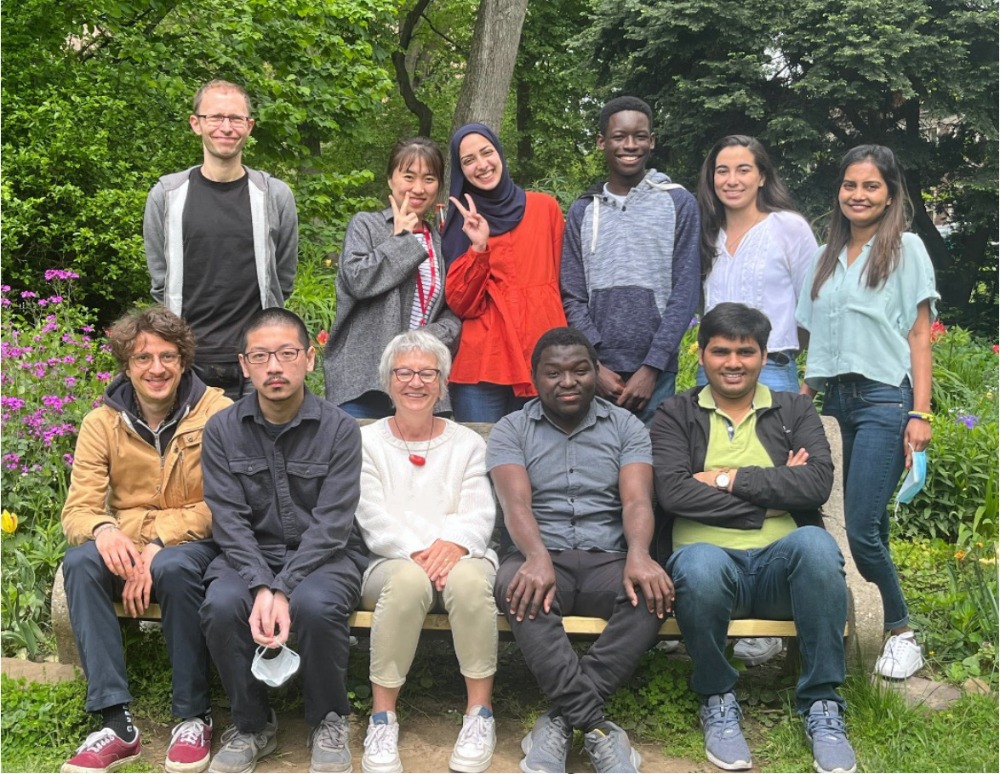
Doris Wagner, Ph.D.
University of Pennsylvania
School of Arts and Sciences
Department of Biology
103G Carolyn Lynch Laboratory
433 South University Avenue
Philadelphia, PA 19104

Topics of study
The role and Regulation of SWI/SNF chromatin remodeling complexes in plants.
ATP-dependent chromatin remodeling can change the chromatin state by using the energy derived from ATP hydrolysis to alter histone/DNA interactions. We uncovered key roles for plant SWI/SNF subfamily remodelers in stem cell maintenance and in overcoming Polycomb repression for induction of the floral homeotic genes during flower patterning. Finally, activity of one of the SWI/SNF remodelers, BRM, is modulated directly by signaling components of the stress hormone ABA for drought tolerance.
Kwon, C.S., Chen, C., and Wagner, D. (2005). WUSCHEL is a primary target for transcriptional regulation by SPLAYED in dynamic control of stem cell fate in Arabidopsis. Genes Development 19, 992-1003.
Bezhani, S., Winter, C., Hershman, S., Wagner, J.D., Kennedy, J.F., Kwon, C.S., Pfluger, J., Su, Y., and Wagner, D. (2007). Unique, Shared, and Redundant Roles for the Arabidopsis SWI/SNF Chromatin Remodeling ATPases BRAHMA and SPLAYED. Plant Cell 19, 403-416.
Han, S.K., Sang, Y., Rodrigues, A., BIOL425F2010, B., Rodriquez, P.L. and Wagner, D. (2012) The SWI2/SNF2 chromatin remodeling ATPase BRAHMA represses Abscisic Acid Responses in the Absence of the Stress Stimulus in Arabidopsis, Plant Cell 24 4892-4906.
Wu, M.F., Sang, Y., Bezhani, S., Yamaguchi, N., Han, S.K., Li, Z., Su, Y., Slewinski, T.L., and Wagner, D. (2012). SWI2/SNF2 chromatin remodeling ATPases overcome polycomb repression and control floral organ identity with the LEAFY and SEPALLATA3 transcription factors. Proceedings of the National Academy of Sciences of the United States of America 109, 3576-3581. http://www.eurekalert.org/pub_releases/2015-10/uop-ph101315.php
Peirats-Llobet, M., Han, S.K., Gonzalez-Guzman, M., Jeong, C.W., Rodriguez, L., Belda-Palazon, B., Wagner, D*., and Rodriguez, P.L*. (2016). A Direct Link between Abscisic Acid Sensing and the Chromatin-Remodeling ATPase BRAHMA via Core ABA Signaling Pathway Components. Molecular Plant 9, 136-147. * corresponding authors
The switch to flower formation, a major developmental switch critical for reproductive success.
Plants generate different types of lateral organs (leaves, then branches and finally flowers) post-embryonically from stem cell descendants at the shoot apex. When flowers form is critical for plant reproductive success. Our research has established that the plant specific helix-turn-helix transcription factor LEAFY is a key regulator of the onset of flower formation. We showed that the regulatory network downstream of LFY is comprised of a set of interlocking feed-forward loops that together control the timing of the upregulation of the direct LFY target APETALA1, a commitment factor of floral fate. We further found that LFY directly alters the hormone environment in newly formed primordia to promote floral fate.
Yamaguchi, A., Wu, M.F., Yang, L., Wu, G., Poethig, R.S., and Wagner, D. (2009). The microRNA-regulated SBP-Box transcription factor SPL3 is a direct upstream activator of LEAFY, FRUITFULL, and APETALA1. Developmental Cell 17, 268-278. (faculty 1000 recommended)
Winter, C.M., Austin, R.S., Blanvillain-Baufume, S., Reback, M.A., Monniaux, M., Wu, M.F., Sang, Y., Yamaguchi, A., Yamaguchi, N., Parker, J.E., J.E., Parcy, F., Jensen, S.T., Li, H., Wagner, D. (2011). LEAFY Target Genes Reveal Floral Regulatory Logic, cis Motifs, and a Link to Biotic Stimulus Response. Developmental Cell 20, 430-443.
Yamaguchi, N., Winter, C., Wu, M-F., Kanno, Y., Yamaguchi, A., Seo, M., and Wagner, D. (2014) Gibberellin acts positively then negatively to control onset of flower formation in Arabidopsis. Science 344, 638-41. https://stke.sciencemag.org/content/7/325/ec127); http://www.eurekalert.org/pub_releases/2014-05/uop-phh050814.php
Zhu, Y., Klasfeld, S., Jeong, C.W., Jin, R., Goto, K., Yamaguchi, N., and Wagner, D. TERMINAL FLOWER 1-FD complex target genes and competition with FLOWERING LOCUS T. Nature Communications, 11, 5118. https://www.eurekalert.org/pub_releases/2020-10/uop-dpg100920.php
Jin, R., Klasfeld, S., Garcia, M.F., Xiao, J., Han, S.K., Konkol, A., Zhu, Y., and Wagner, D.. LEAFY is a pioneer transcription factor and licenses cell reprogramming to floral fate. 2021 Nature Communications, 12(1):626. https://www.eurekalert.org/pub_releases/2021-01/uop-fe012721.php
Organogenesis and differentiation in response to hormonal cues
We have recently become interested in the question how hormone responses control organogenesis and differentiation. We have identified key targets of a master transcriptional regulator of the auxin hormone response, AUXIN RESPONSE FACTOR5/MONOPTEROS during organogenesis (flower primordium initiation) and uncovered an auxin hormone triggered chromatin state switch. In addition, we have elucidated how BRM together with leaf maturation transcription factors triggers leaf differentiation by lowering response to the hormone cytokinin.
Yamaguchi, N., Wu, M.-F., Winter, C., Berns, M., Nole-Wilson, S., Yamaguchi, A., Coupland, G., Krizek, B., and Wagner, D. (2013) Auxin-mediated Initiation of the Flower Primordium. Developmental Cell 24, 1–12. (faculty 1000 recommended)
Efroni, I., Han, S.K., Kim, H.Y., Wu, M.F., Sang, Y., Hong, J.C., Eshed, Y*., and Wagner, D*. (2013). Regulation of leaf maturation by chromatin-mediated modulation of hormonal responses. Developmental Cell. 24, 438-445. *corresponding authors
Wu, M-F, Yamaguchi, N., Xiao J., Bargmann, B. Estelle, M., Sang, Y. and Wagner, D. (2015) Auxin-regulated chromatin switch directs acquisition of flower primordium founder fate. eLife;4:e09269 http://www.eurekalert.org/pub_releases/2015-10/uop-ph101315.php
Chung, Y., Zhu, Y., Wu,M.-F., Simonini, S., Armenta-Medina, A., Jin, R., Østergaard, L., Gillmor, C.S., and Wagner, D. (2019) Auxin Response factors promote organogenesis by chromatin-mediated repression of the pluripotency gene SHOOTMERISTEMLESS. Nature Communications 10, 886.
Polycomb silencing and recruitment in plants
Cell identity depends on silencing of unnecessary or detrimental gene expression programs. To understand the regulation of epigenetic gene silencing we have elucidated how Polycomb Repressive Complexes are targeted to developmental genes in plants. We have uncovered a genome-encoded recruitment mechanism very similar to that previously described in the fruitfly. Our studies pave the way to future epigenetic manipulation of desirable plant traits.
Bossi, F., Fan, J., Xiao, J., Chandra, L., Shen, M., Dorone, Y., Wagner, D., and Rhee, S.Y. (2017). Systematic discovery of novel eukaryotic transcriptional regulators using sequence homology independent prediction. BMC Genomics 18, 480.
Xiao, J., Jin, R., Yu, X., Shen, M., Wagner, J.D., Pai, A., Song, C., Zhuang, M., Klasfeld, S., He, C., Santos, A. M., Helliwell, C., Pruneda-Paz, J. L., Kay, S. A., Lin, X., Cui, S., Garcia, M. F., Clarenz, O., Goodrich, J., Zhang, X., Austin, R. S., Bonasio, R., Wagner, D. (2017). Cis and trans determinants of epigenetic silencing by Polycomb repressive complex 2 in Arabidopsis. Nat Genet. 49 (10) 1546-1552 preview in NG. https://www.eurekalert.org/pub_releases/2017-08/uop-pbs082117.php
Sun, B., Zhou, Y., Cai, J., Shang, E., Yamaguchi, N., Xiao, J., Looi, L.S., Wee, W.Y., Gao, X., Wagner, D. and Ito, T. (2019). Integration of transcriptional repression and Polycomb-mediated silencing of WUSCHEL in floral meristems. Plant Cell.
Bieluszewski, T., Xiao, J., Yang, Y., and Wagner, D. (2021). PRC2 activity, recruitment, and silencing: a comparative perspective. Trends Plant Sci 26, 1186-1198.
Lee, U.S., Bieluszewski, T., Xiao, J., Yamaguchi, A., and Wagner, D. (2022). H2A.Z contributes to trithorax activity at the AGAMOUS locus. Mol Plant 15, 207-210.
Research Interest
(Re)programming Cell Identity and Function in the Context of Chromatin
Our research focuses on the reprogramming of cell identity and function during developmental transitions and in response to environmental inputs in plants. Reprogramming offers a window of opportunity to unravel the regulatory logic that underlies cell fate and function as existing programs are shut down and new one’s are put in place. Plants are an excellent experimental system to address this question as they tailor their final form and cell function to a changing environment to optimize growth and survival. We have shown that master transcriptional regulators, hormone response and chromatin state together orchestrate cell fate reprogramming in plants.
Lab Members
| FIRST NAME | LAST NAME | TITLE | |
|---|---|---|---|
| Doris | Wagner | PI | wagnerdo@sas.upenn.edu |
| Oluwatoyosi (Lisa) | Adaramodu | Rotating Student | dmercylisa@gmail.com |
| Tomasz | Bieluszewski | Postdoc | bieltm@sas.upenn.edu |
| Oresta | Hewryk | Rotating Student | ohewryk@sas.upenn.edu |
| Isabella | Higgins | Rotating Student | isahig@sas.upenn.edu |
| Tian | Huang | PhD Student | ht54@sas.upenn.edu |
| Peter | Ishola | PhD Student | pishola@upenn.edu |
| Yeseul | Kim | Visiting Scholar | warleak@sas.upenn.edu |
| Reggie | Kwarteng | Undergraduate | regkw@upenn.edu |
| Sarah | Matar | Postdoc | matars@sas.upenn.edu |
| Modesola | Olaniyi | Undergraduate | modesola@sas.upenn.edu |
| Sandhan | Prakash | Postdoc | sandhanp@sas.upenn.edu |
| Thomas | Roule | Postdoc | roule@sas.upenn.edu |
| Shalini | Yadav | Postdoc | yshalini@sas.upenn.edu |


